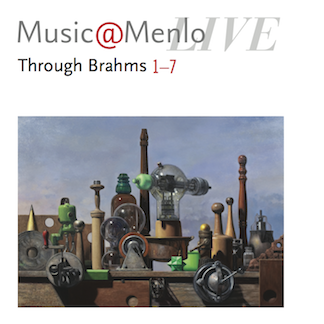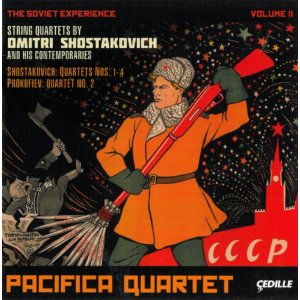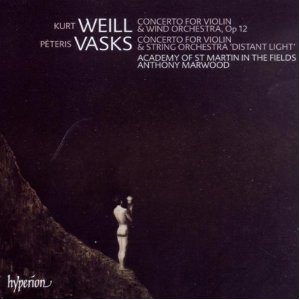|
You are reading the older HTML site
Positive Feedback ISSUE 61
Notes of an Amateur: Music@Menlo, 2011. Pacifica
Quartet's Shostakovich, Volume 2. Marwood Plays
Vasks
Music@Menlo Live. 2011 'Through Brahms.' (7 CD's). Available from www.musicatmenlo.org. What distinguishes the Music@Menlo festival from many others of its kind is its focus each summer on a musical subject that can only be 'taught' through demonstration. In 2011, the subject was Brahms, Brahms heard in the midst of his influential predecessors, contemporaries, and those among his successors on whom he made a significant impression. Brahms is so central to our ears that we have come to take him for granted, even feel we have outgrown him. Some modern composers who find him hard to get around and past have come to disparage him. He is too emotionally direct, too easy! Judged by its ability to get us to hear Brahms freshly, to get around our accumulated impressions of him, "Through Brahms" is one of the most successful programs Music@Menlo has staged yet; and it's the musical context that seems to do the trick. The musicians don't play him differently, they simply play him wonderfully well; but on the same stage as a carefully selected group of works by Bach, Haydn, Schubert, Dvorak, Schoenberg, Ravel, Harbison, Clara and Robert Schumann, even Vivaldi and Mozart. They pull us into a world defined by and furnished with music, not cultural history, not psychology. No words, not even my pathetic ones here, can account for why it works so well. We hear Brahms 'better.' But we also hear him in the music of others, hear what he absorbed and what others absorbed from him. We hear his emotional directness but coming from formal structures he valued enormously and which are easy to overlook, structures that enable the emotions to move us without compromising their complexity. This is mature and masterful romanticism that we moderns find we still can't escape. It challenges the cheaper, simpler romanticisms we frequently find forced on us by our contemporary culture. This seven CD set, which is also available a CD at a time, played by the usual Music@Menlo team of master musicians (most notably Lawrence Lesser and David Finckel, cello; Wu Han and Gilbert Kalish, piano; Arnauld Sussmann and Paul Neubauer, viola; Ani Kavafian and Philip Setzer, violin—among many others) is easily the best and most enjoyable music history/appreciation course I've ever taken. Thanks yet again to program directors David Finckel and Wu Han, and master recording engineer Da-Hong Seeto for assembling it. It will join the six other Music@Menlo sets that sit at the center of my musical collection, the place I turn most often when I want to hear live music but am too lazy to go out and find it. Order at www.musicatmenlo.org. $15 per CD, $90 for the package.
String Quartets by Dimitri Shostakovich, Nos. 1-4; Prokofiev, String Quartet No. 2. Çedille Records CDR 90000130. If you are a Shostakovich String Quartets collector, all you need to know about this second volume of the Pacificas's Shostakovich cycle is that it is of a piece with the first: commanding and superbly enunciated. Have no compunctions about setting it alongside the Borodins, Fitzwilliams, Emersons, and Sorels. It you've yet to choose a set and are not a collector, you need to hear more. The Pacifica Quartet, as demonstrated for many of us with their set of the complete string quartets of Eliot Carter, understand how a modernist quartet is supposed to sound. The emphasis is more on line than color. Line and instrumental texture. Emotional color, tonal saturation is present but between the lines. So the music must be played clearly and briskly with great attention to detail and dynamic shifts. All string quartet musicians who play Bartok, Prokofiev, Ligeti, Carter, Hindemith... and Shostakovich know this. But they don't all execute their understanding with equal power to persuade. And so we get several variations on Shostakovich—some seeming to forget from time to time that there must be something between the lines, some backing off a sense of line to 'humanize' the music, as some might call it, get more heart into it. I am very fond of all of the versions listed above, but this year I'm especially captivated by the Pacificas, who truly seem to get both the mind and heart of the composer. The lines are strong and clear and there is plenty between them as well. Severity and passion strike me as being in perfect balance. Never too wiry, never too warm. I attribute most of this to the musicians, but I'm sure much admired recording engineer Judith Sherman plays a significant role as well. This volume presents Quartets Nos. 1-4 and, in accordance wit the project's intention of providing context ("The Soviet Experience"), we also have Prokofiev's Quartet No. 2. It is paired with Shostakovich's Quartet No. 4 and the differences and similarities we hear are instructive, even if not all of us can explain them.
Kurt Weill, Concerto for Violin and Wind Orchestra. Peteris Vasks, Concerto for Violin and Orchestra: Distant Light. Anthony Marwood, violin and director of the Academy of St. Martins in the Fields. Hyperon CDA 67496. One of the most appealing aspects of Anthony Marwood's solo career is his willingness to seek out and record excellent but lesser known works—not the usual path of a rising star with eyes on the prize. Most recently, Britten's concerto and a few years back (2004) these concertos by Kurt Weill (1924) and Peteris Vasks (1996-97). I expect very few of us have heard the Weill, but the Vasks is a better know work and a great treasure. We can hear Weill's well known stage works (Three Penny Opera, etc.) presaged in his concerto, which is otherwise a busy, neo-classic piece of virtuosity that has some of the characteristics of Stravinsky but, like Hindemith, not much of his melodic splendor. It takes a highly accomplished musician just to get this work off the page and Marwood is surely that. The Vasks is another matter altogether. It as been recorded brilliantly by Gidon Kremer and John Storgärds, both of whom set high standards. It is a hauntingly evocative work, which tempts violinists to indulge themselves. Fortunately this is not Marwood's way with any music, he who premiered Thomas Adès' starkly modernist concerto and recorded, with Adès, Stravinsky's cool and eloquent music for violin and piano. Marwood's tone is pure, his approach restrained and objective, expressing both his respect and affection for the Vasks concerto, allowing the work to bloom in all its exquisite, elegiac beauty. Marwood also conducts the orchestra in this performance, which enables his power through restraint to carry over the orchestra. This concerto can take a variety of interpretations, it is so good. But do not miss Marwood's. Equipment used for this audition: Audio Note CDT 4 transport; Blue Circle BC501obLOC dac; Crimson CS710 solid state preamplifier & CDS640E solid state monoblock amplifier; Jean Marie Reynaud Offrande Supreme, V2 loudspeakers; Crimson cables. Bob Neill, in addition to being an occasional equipment and regular music reviewer for Positive- Feedback Online, is also proprietor of Amherst Audio in Amherst, Massachusetts, which sells equipment from Audio Note, Blue Circle, JM Reynaud, and Crimson Audio.
|



